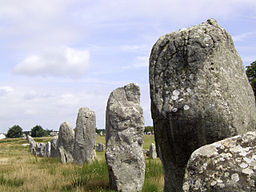Prehistoric Age
The history of France between 43000 BC and 701 BC
Stone tools indicate that early humans were present in France at least 1.57 million years ago. The Grotte du Vallonnet near Menton contained simple stone tools dating to 1 million to 1.05 million years BC. Cave sites were exploited for habitation, but the hunter-gatherers of the Palaeolithic era also possibly built shelters such as those identified in connection with Acheulean tools at Grotte du Lazaret and Terra Amata near Nice in France. Excavations at Terra Amata found traces of the earliest known domestication of fire in Europe, from 400,000 BC.
The Neanderthals, the earliest human species to occupy Europe, are thought to have arrived there around 300,000 BC, but seem to have died out by about by 30,000 BC, presumably unable to compete with modern humans during a period of cold weather. The earliest modern humans – Cro-Magnons – were present in Europe by 43,000 years ago during a long interglacial period of particularly mild climate, when Europe was relatively warm, and food was plentiful. When they arrived in Europe, they brought with them sculpture, engraving, painting, body ornamentation, music and the painstaking decoration of utilitarian objects. Some of the oldest works of art in the world, such as the cave paintings at Lascaux in southern France, are datable to shortly after this migration.
The Neolithic Age
The Neolithic period lasted in northern Europe for approximately 3,000 years (c. 4500 BC–1700 BC). It is characterised by the so-called Neolithic Revolution, a transitional period that included the adoption of agriculture, the development of tools and pottery, and the growth of larger, more complex settlements. Many European Neolithic groups share basic characteristics, such as living in small-scale family-based communities, subsisting on domestic plants and animals supplemented with the collection of wild plant foods and with hunting, and producing hand-made pottery. Archeological sites in France include artifacts from the Linear Pottery culture (c. 5500-4500 BC), the Rössen culture (c. 4500—4000 BC), and the Chasséen culture (4,500 - 3,500 BC), the name given to the late Neolithic pre-Beaker culture that spread throughout the plains and plateaux of France, including the Seine basin and the upper Loire valleys.
It is most likely from the Neolithic that date the megalithic (large stone) monuments, such as the dolmens, menhirs, stone circles and chamber tombs, found throughout France, the largest selection of which are in the Brittany and Auvergne regions. The most famous of these are the Carnac stones (c. 3300 BC, but may date to as old as 4500 BC) and the stones at Saint-Sulpice-de-Faleyrens.
The Bronze Age
The early Bronze Age archeological cultures in France include the transitional Beaker culture (c. 2800–1900 BC), the Tumulus culture (c. 1600-1200 BC) and Urnfield culture (c. 1300-800 BC). Bronze Age sites in Brittany are believed to have grown out of Beaker roots, with some Wessex culture and Unetice culture influence. Some scholars think that the Urnfield culture represents an origin for the Celts as a distinct cultural branch of the Indo-European family. This culture was preeminent in central Europe during the late Bronze Age; the Urnfield period saw a dramatic increase in population in the region, probably due to innovations in technology and agricultural practices.
References: Wikipedia
